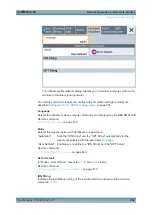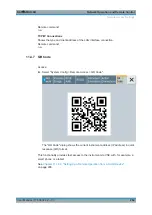
Network Operation and Remote Control
R&S
®
SMA100B
258
User Manual 1178.3834.02 ─ 03
●
Exchanging hardware
Errors can affect the entire network.
"Auto (DCHP)"
Assigns the IP address automatically, provided the network supports
DHCP (Dynamic Host Configuration Protocol).
"Static"
Enables you to assign the IP address manually.
Remote command:
:SYSTem:COMMunicate:NETWork:IPADdress:MODE
IP Address
Displays the IP address of the instrument in the network.
By default, the R&S
SMA100B is configured to use dynamic TCP/IP configuration and
to obtain the whole address information automatically.
If the network does not support DHCP or the attempt does not succeed, the instrument
tries to obtain the IP address via Zeroconf (APIPA) protocol. IP addresses assigned via
Zeroconf start with the number blocks
169.254.*.*
.
Note:
An IP address that is assigned via the Zeroconf protocol although the network
requires an IP address assigned via the DHCP server can cause network connection
failures.
See
Chapter 14.5, "Resolving Network Connection Failures"
To assign the IP address manually, select
Remote command:
:SYSTem:COMMunicate:NETWork:IPADdress
Subnet Mask
Displays the bit group of the subnet in the host identifier.
To assign the subnet mask manually, select
Remote command:
:SYSTem:COMMunicate:NETWork[:IPADdress]:SUBNet:MASK
Default Gateway
Displays the gateway address.
This address identifies the router on the same network as the instrument that is used to
forward traffic to destinations beyond the local network.
To assign the gateway address manually, select
> "Static".
Remote command:
:SYSTem:COMMunicate:NETWork[:IPADdress]:GATeway
DNS Suffix
Displays the primary DNS (Domain Name System) suffix, that means the DNS name
without the hostname part.
The DNS system uses the suffix for registration and name resolution for unique identifi-
cation of the instrument in the entire network.
To assign the DNS suffix manually, select
> "Static".
Remote Access Settings
















































